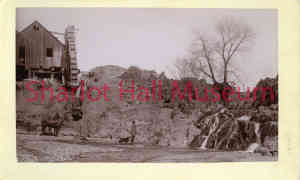Agua Fria Water Wheel
details
Erwin Baer Unknown 1600.0199.0001.jpg M - 199 B&W 1600-0199-0001 m199pa Photo Card Print 5x7 Historic Photographs 1890s Reproduction requires permission. Digital images property of SHM Library & ArchivesDescription
Agua Fria River water wheel, Yavapai County, Arizona Territory, c. 1890's.
Photograph of a man, with his horses and dog, pointing at a small outflow cascade of water from the Agua Fria River. A mining water wheel and mill is behind him.
Separating valuable metal from the waste rock was seldom an easy task. The earliest, simplest and most affordable method of crushing ore was with the use of an arrastra. Arrastras (also “rastra” or “arastra”) had their origins in Mexico. They were the earliest type and used during the California Gold Rush in the 1850s. These devices consisted of a flat track of stone inside a low wall of rock or wood, a retaining basin to capture and hold the ore, and a center post and horizontal shaft made of wood or from small tree trunks. The ease by which they were built and operated made them ideally suited to small mining operations. Powered by horse or mule, the shaft would drag one or more large stones in a circular path on top of the flat stone base, crushing the ore that has been placed in the basin. When water was plentiful, flumes and water wheels were often used instead of animal power.
More elaborate arrastra mills were often housed in a building and powered by water from flumes or even steam power. As mining technology evolved, arrastras and water wheels were replaced by much larger and more effective milling methods and machinery. Stamp mills became the best way to crush and process bulk rock at most mines when adequate capital was available.
Purchase
To purchase this image please click on the NOTIFY US button and we will contact you with details
The process for online purchase of usage rights to this digital image is under development. To order this image, CLICK HERE to send an email request for details. Refer to the ‘Usage Terms & Conditions’ page for specific information. A signed “Permission for Use” contract must be completed and returned. Written permission from Sharlot Hall Museum is required to publish, display, or reproduce in any form whatsoever, including all types of electronic media including, but not limited to online sources, websites, Facebook Twitter, or eBooks. Digital files of images, text, sound or audio/visual recordings, or moving images remain the property of Sharlot Hall Museum, and may not be copied, modified, redistributed, resold nor deposited with another institution. Sharlot Hall Museum reserves the right to refuse reproduction of any of its materials, and to impose such conditions as it may deem appropriate. For certain scenarios, the price for personal usage of the digital content is minimal; CLICK HERE to download the specific form for personal usage. For additional information, contact the Museum Library & Archives at 928-445-3122 ext. 14 or email: orderdesk@sharlot.org.




